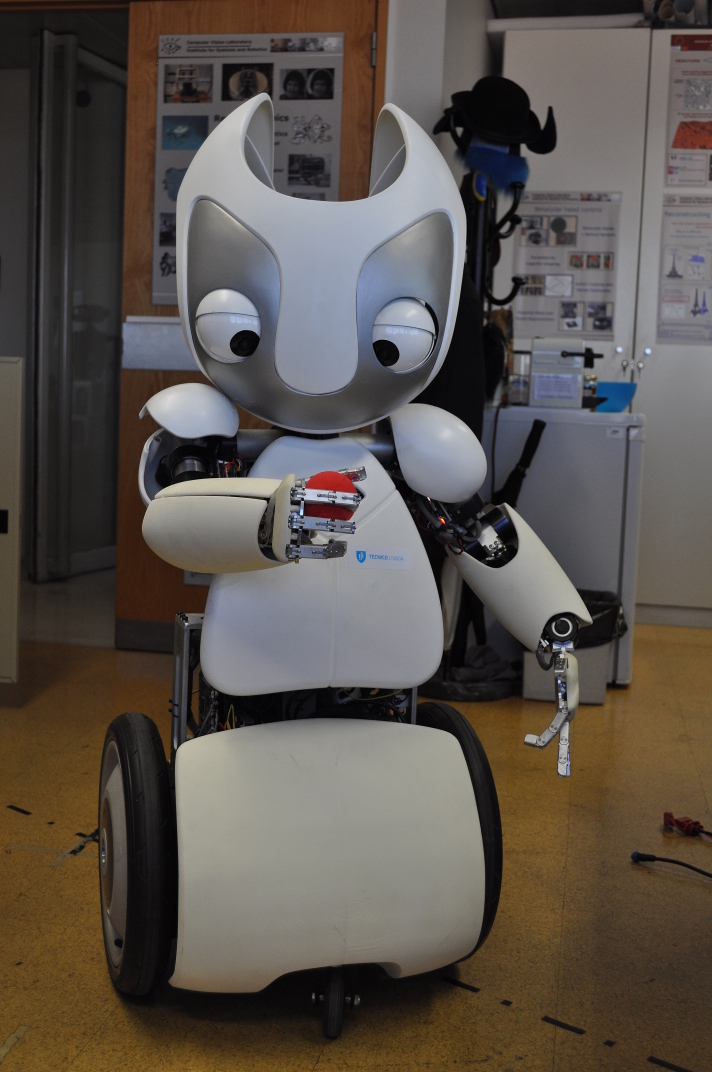This is Vizzy's "oh so amazing" repository!
This repository contains the necessary tools to interact with Vizzy - both on simulation and real robot usage.
The real robot uses two different middlewares for distinct body parts (YARP for the upperbody and ROS for the mobile base). In simulation there are two options in terms of middleware - one aligned with the real robot (using YARP and ROS) and one aiming simulation experiences (using exclusively ROS).
- vizzy_launch: Contains the launch files to interact with Vizzy (both on simulation and real robot usage). For most users it is the only package they need to directly use.
- vizzy_description: Contains all of Vizzy's description files (regarding mechanical, kinematic, visual, etc). You can use its launcher called
display.launchto check the model with the Rviz graphical tool. - vizzy_gazebo: Holds the launch files needed to simulate the robot on the GAZEBO simulator.
- vizzy_navigation: Contains the launch files for several packages of the ROS navigation stack.
- vizzy_control: Low-level controllers for Vizzy's simulation.
- vizzy_sensors: Package holding the Hokuyo filters for better scannings.
- vizzy_yarp_icub: YARP based controllers, drivers, libraries and modules. Cartesian controllers, gaze controller, ball tracker grasping demo, yoga demo.
- vizzy_speech: Cointains the node to made vizzy speak.
Note that for simulation purposes one can ignore all YARP dependencies as explained on the repository description.
- Operating System
- Ubuntu 16.04 - Currently supported version, Ubuntu 16.04 and ROS Kinetic-Kame
- Middleware
- Other Dependencies
- GAZEBO - It needs GAZEBO greather or equal than 5 to run the gazebo-yarp-plugins. Currently tested in Gazebo 7 and 9 as well.
- gazebo-yarp-plugins - we try to keep everything working with the most recent version of gazebo-yarp-plugins
At any time you might need to install some more specific dependencies (like some missing ROS packages). Please open an issue in case you can't solve these or other dependencies.
You should have a catkin workspace on your file system to be able to compile the code. If you don't know how to do this please follow these instructions.
As soon as you have your catkin_workspace configured you are ready to open a terminal and run the following instructions:
cd /path/to/your/catkin/workspace/src
git clone https://github.com/vislab-tecnico-lisboa/vizzy
Be sure to add the source folder of your catkin workspace to the ROS_PACKAGE_PATH variable (skip this step if you already did it):
gedit ~/.bashrc
Add the following line to the end of the file:
export ROS_PACKAGE_PATH=/path/to/your/catkin/workspace/src:$ROS_PACKAGE_PATH
Save the file and run:
source ~/.bashrc
You still need to add something to the GAZEBO_MODEL_PATH:
gedit ~/.bashrc
(Yeah I know we could have done this on the previous step but I was afraid people would skip the last step without noticing this export...sorry)
export GAZEBO_MODEL_PATH=/path/to/your/catkin/workspace/src/vizzy/vizzy_gazebo:$GAZEBO_MODEL_PATH
Save the file and run:
source ~/.bashrc
Install the nav2d package
version=kinetic &&
sudo apt-get install ros-$version-nav2d
If you want to run the follower module, download a changed version of the nav2d and place it in your catkin workspace folder
git clone https://github.com/joao-avelino/navigation_2d.git
We are currently migrating the eband planner to teb planner.
Other dependencies needed (in a convenient one-liner)
version=kinetic &&
sudo apt-get install ros-$version-tf2-geometry-msgs
sudo apt install ros-$version-gazebo-* &&
sudo apt install ros-$version-image-proc &&
sudo apt install ros-$version-moveit-* &&
sudo apt install ros-$version-opencv* &&
sudo apt install ros-$version-image-proc &&
sudo apt install ros-$version-gazebo-ros-control &&
sudo apt install ros-$version-move-base &&
sudo apt install ros-$version-amcl &&
sudo apt install ros-$version-joy &&
sudo apt install ros-$version-map-server &&
sudo apt install ros-$version-joint-state-controller &&
sudo apt install ros-$version-velocity-controllers &&
sudo apt install ros-$version-position-controllers &&
sudo apt install ros-$version-joint-trajectory-controller &&
sudo apt install ros-$version-eband-local-planner &&
sudo apt install ros-$version-laser-filters &&
sudo apt install libsuitesparse-dev &&
sudo apt install ros-$version-fake-localization &&
sudo apt install ros-$version-move-slow-and-clear
You are now ready to compile the code!
The compilation is quite straightforward. Just open a terminal:
cd /path/to/your/catkin/workspace
catkin_make --pkg vizzy_msgs
catkin_make --pkg id_selector
catkin_make
Hmm... does this seems to easy? I hope it does because you should now be ready to interact with Vizzy!
For now let's focus on simulation. Open a terminal:
roslaunch vizzy_launch vizzy_simulation.launch
This configuration starts Vizzy in the ROS-mode, meaning that all the controllers are emulated using ROS. This configuration works with Gazebo 7.x and ROS kinetic (The default install procedure of ROS kinetic) and also with Gazebo 9 and ROS kinetic
The upper body controllers simulated by the gazebo-yarp-plugins can be started by
yarpserver
roslaunch vizzy_launch vizzy_simulation.launch use_yarp:=true
Don't forget you'll need to have yarpserver running when you have the use_yarp argument set as true.
Feel free to play with the arguments as you want or to change the low-level launchers with more functionality.
To access pulseaudio and all the sound options through the network you need to make it discoverable. For that use:
paprefs
Add the vizzy user to the audio group
sudo usermod -aG audio,pulse,pulse-access `whoami`
In order to access the audio configurations via SSH you need to define the the following environment variable on Vizzy:
export PULSE_SERVER=127.0.0.1
Furthermore, without a X11 session the PulseAudio server will not launch automatically since it normally requires X11. To run PulseAudio in a headless machine you need to run it in daemon mode:
pulseaudio -D
This should be launched automatically, but if the audio is not working you should check if the pulseaudio server is running. If not, execute the previous command and it should work.
To control the audio volume use
alsamixer
Now you can access audio configurations via ssh -X. Useful commands:
gnome-control-center
pavucontrol
pacmd
For more details see the following reference:
@inproceedings{moreno2016vizzy,
title={Vizzy: A humanoid on wheels for assistive robotics},
author={Moreno, Plinio and Nunes, Ricardo and Figueiredo, Rui and Ferreira, Ricardo and Bernardino, Alexandre and Santos-Victor, Jos{\'e} and Beira, Ricardo and Vargas, Lu{\'\i}s and Arag{\~a}o, Duarte and Arag{\~a}o, Miguel},
booktitle={Robot 2015: Second Iberian Robotics Conference},
pages={17--28},
year={2016},
organization={Springer}
}
All kind of issues and contributions will be very welcome. Please get in touch on our issues page when help is needed!
